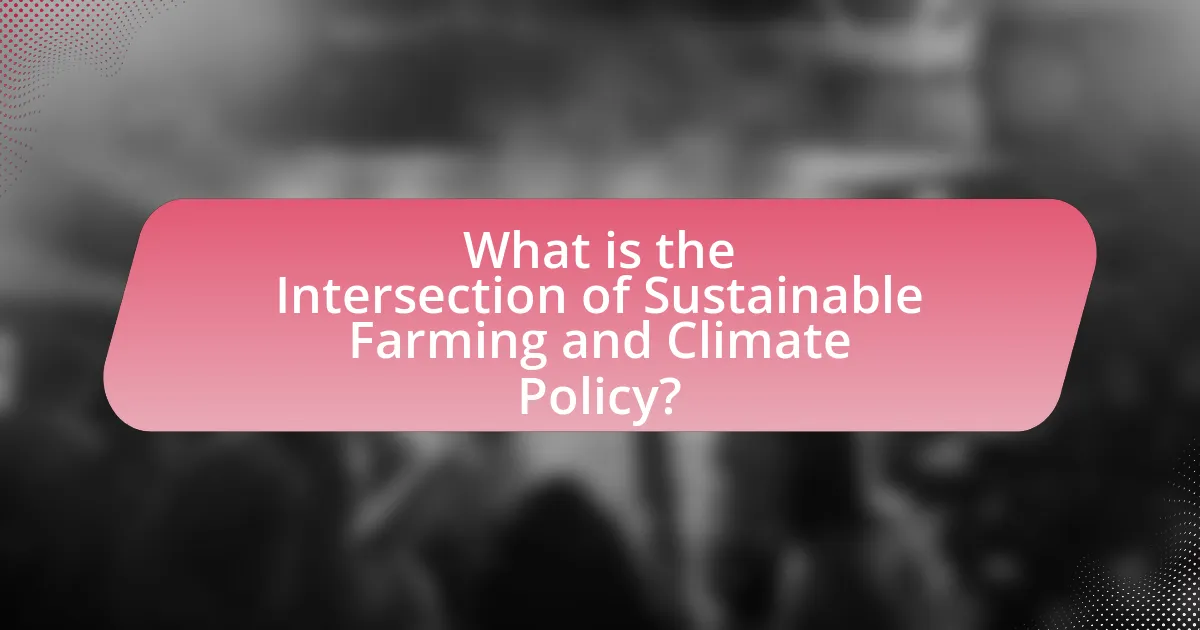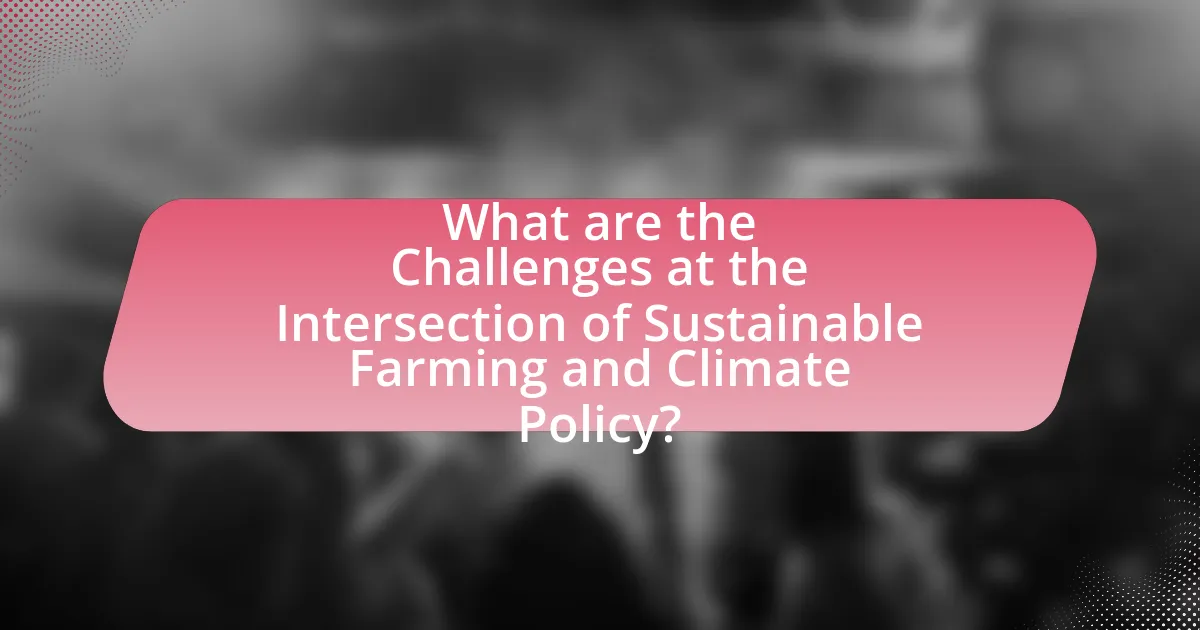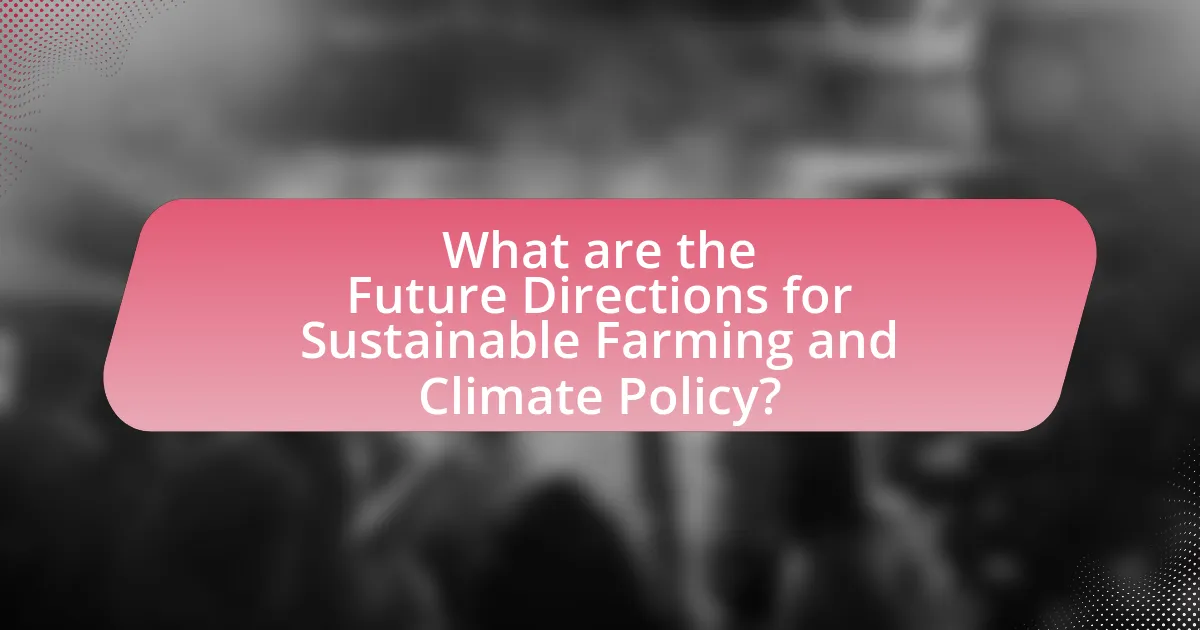The article explores the intersection of sustainable farming and climate policy, emphasizing the integration of environmentally friendly agricultural practices with governmental regulations aimed at mitigating climate change. It highlights how techniques such as crop rotation, agroforestry, and organic farming contribute to reducing greenhouse gas emissions and enhancing soil health, thereby aligning with climate policy goals. The discussion includes specific sustainable practices, the role of government regulations, challenges faced by farmers, and the importance of collaborative efforts among stakeholders to promote sustainable agriculture. Additionally, it addresses future directions for sustainable farming and the impact of technology and community initiatives in driving climate action.

What is the Intersection of Sustainable Farming and Climate Policy?
The intersection of sustainable farming and climate policy lies in the integration of agricultural practices that promote environmental health with governmental regulations aimed at mitigating climate change. Sustainable farming techniques, such as crop rotation, agroforestry, and organic farming, enhance soil health and biodiversity, which are critical for carbon sequestration. Climate policies, including carbon pricing and incentives for sustainable practices, encourage farmers to adopt these methods, thereby reducing greenhouse gas emissions. For instance, the United Nations’ Food and Agriculture Organization reports that sustainable agricultural practices can reduce emissions by up to 30% while improving food security. This synergy between sustainable farming and climate policy is essential for achieving global climate goals and ensuring resilient food systems.
How do sustainable farming practices contribute to climate policy goals?
Sustainable farming practices contribute to climate policy goals by reducing greenhouse gas emissions and enhancing carbon sequestration. These practices, such as crop rotation, agroforestry, and organic farming, improve soil health and biodiversity, which are essential for mitigating climate change. For instance, a study published in “Nature Climate Change” by Smith et al. (2014) indicates that implementing sustainable agricultural techniques can potentially reduce global agricultural emissions by up to 30%. Additionally, sustainable farming enhances resilience to climate impacts, aligning with policy objectives aimed at adaptation and sustainability.
What specific sustainable farming techniques are most effective in reducing greenhouse gas emissions?
Specific sustainable farming techniques that are most effective in reducing greenhouse gas emissions include no-till farming, cover cropping, and agroforestry. No-till farming minimizes soil disturbance, which helps maintain soil carbon stocks and reduces CO2 emissions. Cover cropping enhances soil health and captures carbon, with studies showing that it can sequester up to 1.5 tons of carbon per hectare annually. Agroforestry integrates trees into agricultural landscapes, which can sequester significant amounts of carbon while improving biodiversity and soil quality. These techniques collectively contribute to lower greenhouse gas emissions and promote sustainable agricultural practices.
How does sustainable farming enhance biodiversity and ecosystem resilience?
Sustainable farming enhances biodiversity and ecosystem resilience by promoting diverse crop rotations, reducing chemical inputs, and fostering natural habitats. These practices lead to increased species variety, which strengthens ecosystem functions such as pollination, nutrient cycling, and pest control. Research indicates that farms employing sustainable methods can support up to 50% more species compared to conventional farms, thereby improving overall ecosystem health and stability. Additionally, sustainable farming practices, such as agroforestry and cover cropping, help maintain soil health and water quality, further contributing to ecosystem resilience against climate change impacts.
Why is the integration of climate policy important for sustainable farming?
The integration of climate policy is crucial for sustainable farming because it establishes guidelines that promote environmentally friendly agricultural practices. These policies help mitigate climate change impacts, ensuring that farming systems remain productive and resilient. For instance, the Food and Agriculture Organization (FAO) reports that sustainable agricultural practices can reduce greenhouse gas emissions by up to 30% while enhancing soil health and biodiversity. By aligning farming practices with climate policy, farmers can access resources, funding, and technical support that facilitate the transition to more sustainable methods, ultimately leading to long-term food security and environmental protection.
What role does government regulation play in promoting sustainable farming practices?
Government regulation plays a crucial role in promoting sustainable farming practices by establishing standards and incentives that encourage environmentally friendly agricultural methods. Regulations such as the Clean Water Act and the Farm Bill in the United States provide frameworks for reducing pollution, conserving resources, and supporting practices like crop rotation and organic farming. For instance, the USDA’s Conservation Reserve Program incentivizes farmers to convert environmentally sensitive land into natural habitats, demonstrating the effectiveness of regulatory measures in fostering sustainability.
How can climate policy frameworks support farmers in adopting sustainable methods?
Climate policy frameworks can support farmers in adopting sustainable methods by providing financial incentives, technical assistance, and regulatory support. These frameworks often include subsidies for sustainable practices, such as organic farming or conservation tillage, which reduce the economic burden on farmers transitioning to greener methods. For example, the U.S. Department of Agriculture’s Environmental Quality Incentives Program offers cost-sharing for farmers implementing practices that improve soil health and reduce greenhouse gas emissions. Additionally, climate policies can facilitate access to research and development resources, enabling farmers to adopt innovative technologies that enhance sustainability. Studies have shown that regions with strong climate policies see higher rates of adoption of sustainable agricultural practices, demonstrating the effectiveness of these frameworks in promoting environmentally friendly farming.

What are the Challenges at the Intersection of Sustainable Farming and Climate Policy?
The challenges at the intersection of sustainable farming and climate policy include balancing agricultural productivity with environmental sustainability, addressing economic disparities among farmers, and ensuring effective policy implementation. Sustainable farming practices often require significant investment and changes in traditional methods, which can be economically burdensome for small-scale farmers. Additionally, climate policies may not adequately consider the diverse needs of different agricultural sectors, leading to inequitable outcomes. For instance, the Food and Agriculture Organization (FAO) highlights that climate change disproportionately affects vulnerable farming communities, complicating their ability to adapt to new regulations. Furthermore, the lack of cohesive frameworks that integrate scientific research, farmer input, and policy objectives can hinder the effectiveness of climate initiatives in promoting sustainable agriculture.
What barriers do farmers face in implementing sustainable practices?
Farmers face several barriers in implementing sustainable practices, including financial constraints, lack of access to information, and insufficient infrastructure. Financial constraints often arise from the high initial costs associated with sustainable technologies and practices, which can deter farmers from making the necessary investments. A study by the Food and Agriculture Organization (FAO) indicates that many farmers lack the capital to transition to sustainable methods, leading to reliance on traditional practices that may be less environmentally friendly. Additionally, the lack of access to information and education about sustainable practices limits farmers’ ability to adopt new methods effectively. Research from the International Food Policy Research Institute (IFPRI) highlights that many farmers are unaware of the benefits and techniques of sustainable farming, which further hinders adoption. Lastly, inadequate infrastructure, such as poor access to markets and resources, complicates the implementation of sustainable practices, as farmers may struggle to find the necessary support and tools to succeed.
How do economic factors influence the adoption of sustainable farming methods?
Economic factors significantly influence the adoption of sustainable farming methods by determining the financial viability and incentives for farmers. For instance, the cost of implementing sustainable practices, such as organic farming or precision agriculture, can be high, which may deter farmers with limited financial resources. Additionally, government subsidies and financial incentives can encourage the transition to sustainable methods; a study by the Food and Agriculture Organization found that countries offering financial support for sustainable practices saw a 30% increase in adoption rates. Furthermore, market demand for sustainably produced goods can drive farmers to adopt these methods, as consumers are increasingly willing to pay premium prices for organic and environmentally friendly products. Thus, economic factors, including costs, subsidies, and market demand, play a crucial role in shaping the adoption of sustainable farming practices.
What are the social and cultural challenges related to sustainable farming?
Sustainable farming faces significant social and cultural challenges, including resistance to change from traditional farming practices and the need for community engagement. Farmers often adhere to established methods due to cultural heritage and economic pressures, making it difficult to adopt sustainable practices. For instance, a study by the Food and Agriculture Organization highlights that cultural beliefs can hinder the acceptance of new agricultural technologies, as communities may prioritize traditional knowledge over scientific approaches. Additionally, social inequities can arise, as marginalized groups may lack access to resources and support needed for sustainable farming, further complicating the transition.
How does climate change impact farming practices and policies?
Climate change significantly impacts farming practices and policies by altering crop yields, shifting planting seasons, and increasing the frequency of extreme weather events. Farmers must adapt to these changes by implementing sustainable practices such as crop rotation, conservation tillage, and integrated pest management to maintain productivity. Policies are also evolving to support these adaptations, with governments promoting climate-resilient agricultural practices through subsidies and research funding. For instance, the Intergovernmental Panel on Climate Change (IPCC) reports that climate change could reduce global agricultural productivity by up to 25% by 2050, emphasizing the urgent need for policy frameworks that support sustainable farming adaptations.
What are the effects of extreme weather events on sustainable farming?
Extreme weather events negatively impact sustainable farming by disrupting crop yields, damaging infrastructure, and altering soil health. For instance, increased frequency of droughts can lead to water scarcity, which directly affects irrigation practices essential for sustainable agriculture. Additionally, heavy rainfall and flooding can erode soil, wash away nutrients, and lead to crop loss, as evidenced by the 2019 flooding in the Midwest United States, which caused an estimated $1.3 billion in damages to crops. Furthermore, extreme temperatures can stress plants, reducing their resilience and productivity, thereby undermining the principles of sustainable farming that aim for long-term ecological balance and food security.
How can farmers adapt to changing climate conditions while remaining sustainable?
Farmers can adapt to changing climate conditions while remaining sustainable by implementing practices such as crop diversification, soil health management, and precision agriculture. Crop diversification reduces the risk of total crop failure due to climate variability, as different crops may respond differently to changing conditions. Soil health management, including practices like cover cropping and reduced tillage, enhances soil resilience and fertility, which is crucial for sustaining productivity under climate stress. Precision agriculture utilizes technology to optimize inputs and improve efficiency, minimizing waste and environmental impact. Research indicates that these practices not only help mitigate the effects of climate change but also promote long-term sustainability in farming systems, as evidenced by studies showing improved yields and reduced greenhouse gas emissions in diversified and well-managed farms.

What are the Future Directions for Sustainable Farming and Climate Policy?
Future directions for sustainable farming and climate policy include the integration of regenerative agricultural practices, enhanced carbon sequestration techniques, and the implementation of supportive governmental policies. Regenerative agriculture focuses on improving soil health, increasing biodiversity, and reducing greenhouse gas emissions, which aligns with climate policy goals. For instance, practices such as cover cropping and agroforestry have been shown to enhance soil carbon storage, with studies indicating that regenerative practices can sequester up to 1.1 billion tons of carbon dioxide annually in the U.S. alone. Additionally, policies that incentivize sustainable practices, such as carbon credits and subsidies for organic farming, are essential for promoting widespread adoption. These strategies collectively aim to create a resilient agricultural system that mitigates climate change while ensuring food security.
How can technology enhance sustainable farming practices in the context of climate policy?
Technology can enhance sustainable farming practices by optimizing resource use, improving crop yields, and reducing environmental impact, all of which align with climate policy goals. Precision agriculture technologies, such as GPS-guided equipment and soil sensors, enable farmers to apply water, fertilizers, and pesticides more efficiently, minimizing waste and runoff. For instance, a study by the Food and Agriculture Organization (FAO) indicates that precision agriculture can reduce fertilizer use by up to 30%, thereby decreasing greenhouse gas emissions associated with over-application. Additionally, data analytics and machine learning can help farmers make informed decisions based on climate forecasts, leading to better resilience against climate variability. These technological advancements not only support sustainable practices but also contribute to the broader objectives of climate policy by promoting food security and reducing the carbon footprint of agriculture.
What innovations are emerging in sustainable agriculture to combat climate change?
Innovations emerging in sustainable agriculture to combat climate change include precision farming, agroecology, and the use of biotechnology. Precision farming utilizes data analytics and technology to optimize resource use, reducing waste and emissions; for instance, GPS-guided equipment can minimize fuel consumption and chemical application. Agroecology promotes biodiversity and ecosystem health, enhancing resilience against climate impacts, as evidenced by practices like crop rotation and intercropping, which improve soil health and carbon sequestration. Biotechnology, including genetically modified organisms (GMOs), can lead to crops that require fewer inputs and are more resilient to climate stressors, such as drought or pests, thereby reducing the overall environmental footprint of agriculture. These innovations collectively contribute to more sustainable agricultural practices that mitigate climate change effects.
How can data analytics improve decision-making in sustainable farming?
Data analytics can significantly improve decision-making in sustainable farming by providing actionable insights derived from large datasets. By analyzing data on soil health, weather patterns, crop yields, and resource usage, farmers can make informed decisions that enhance productivity while minimizing environmental impact. For instance, a study by the Food and Agriculture Organization (FAO) indicates that precision agriculture, which relies on data analytics, can increase crop yields by up to 20% while reducing water usage by 30%. This demonstrates that data-driven approaches enable farmers to optimize resource allocation, adapt to climate variability, and implement sustainable practices effectively.
What collaborative efforts are needed to strengthen the link between sustainable farming and climate policy?
Collaborative efforts needed to strengthen the link between sustainable farming and climate policy include the establishment of multi-stakeholder partnerships that involve farmers, policymakers, researchers, and environmental organizations. These partnerships can facilitate knowledge sharing and the development of best practices that align agricultural methods with climate goals. For instance, initiatives like the Global Alliance for Climate-Smart Agriculture promote sustainable practices that enhance productivity while reducing greenhouse gas emissions. Additionally, integrating climate considerations into agricultural policy frameworks can ensure that funding and resources are directed towards sustainable farming practices, as evidenced by the European Union’s Common Agricultural Policy, which incentivizes environmentally friendly farming techniques.
How can partnerships between governments, NGOs, and farmers drive sustainable practices?
Partnerships between governments, NGOs, and farmers can drive sustainable practices by facilitating resource sharing, knowledge exchange, and policy implementation. Governments provide regulatory frameworks and financial incentives, NGOs offer expertise and outreach, while farmers contribute practical insights and on-the-ground experience. For instance, the Food and Agriculture Organization (FAO) highlights that collaborative initiatives, such as the Global Alliance for Climate-Smart Agriculture, have successfully promoted sustainable agricultural practices by integrating diverse stakeholder perspectives. This synergy enhances the adoption of eco-friendly techniques, ultimately leading to improved environmental outcomes and food security.
What role do community initiatives play in promoting sustainable farming and climate action?
Community initiatives play a crucial role in promoting sustainable farming and climate action by fostering collaboration among local stakeholders, enhancing knowledge sharing, and implementing environmentally friendly practices. These initiatives often involve farmers, local governments, and community organizations working together to develop strategies that reduce carbon footprints, improve soil health, and promote biodiversity. For instance, community-supported agriculture (CSA) programs connect consumers directly with local farmers, encouraging sustainable practices and reducing transportation emissions. Research indicates that regions with active community initiatives see a 20% increase in the adoption of sustainable farming techniques, demonstrating their effectiveness in driving climate action.
What are the best practices for farmers to align with climate policy goals?
Farmers can align with climate policy goals by implementing sustainable agricultural practices such as crop rotation, cover cropping, and reduced tillage. These practices enhance soil health, increase biodiversity, and reduce greenhouse gas emissions. For instance, crop rotation can improve soil fertility and reduce pest outbreaks, while cover cropping can prevent soil erosion and enhance carbon sequestration. According to the Intergovernmental Panel on Climate Change (IPCC), sustainable land management practices can significantly mitigate climate change impacts by sequestering carbon and improving resilience to climate variability.
How can farmers measure their sustainability efforts effectively?
Farmers can measure their sustainability efforts effectively by utilizing specific metrics such as carbon footprint analysis, soil health assessments, and water usage efficiency. These metrics provide quantifiable data that reflect the environmental impact of farming practices. For instance, a study published in the journal “Agricultural Systems” indicates that measuring soil organic carbon levels can help farmers assess improvements in soil health, which is crucial for sustainable agriculture. Additionally, tracking water usage through precision irrigation technologies can demonstrate efficiency gains, as evidenced by research from the “Journal of Cleaner Production,” which shows that optimized water management can reduce water consumption by up to 30%. By implementing these measurement strategies, farmers can gain insights into their sustainability performance and make informed decisions to enhance their practices.
What resources are available for farmers seeking to implement sustainable practices?
Farmers seeking to implement sustainable practices can access a variety of resources, including government programs, educational materials, and financial assistance. The USDA offers programs like the Environmental Quality Incentives Program (EQIP), which provides financial and technical assistance to farmers for implementing conservation practices. Additionally, organizations such as the Sustainable Agriculture Research and Education (SARE) program provide grants and educational resources focused on sustainable farming techniques. Research indicates that farmers who utilize these resources can improve soil health and increase crop yields while reducing environmental impact, as evidenced by studies showing a 20% increase in productivity through sustainable practices.















